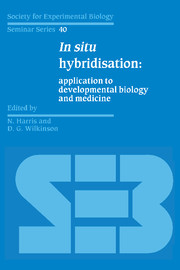Book contents
- Frontmatter
- Contents
- List of contributors
- Preface
- Non-radioisotopic labels for in situ hybridisation histochemistry: a histochemist's view.
- Use of haptenised nucleic acid probes in fluorescent in situ hybridisation
- The use of complementary RNA probes for the identification and localisation of peptide messenger RNA in the diffuse neuroendocrine system
- Contributions of the spatial analysis of gene expression to the study of sea urchin development
- Advantages and limitations of in situ hybridisation as exemplified by the molecular genetic analysis of Drosophila development
- The use of in situ hybridisation to study the localisation of maternal mRNAs during Xenopus oogenesis
- In situ hybridisation in the analysis of genes with potential roles in mouse embryogenesis
- Evolution of algal plastids from eukaryotic endosymbionts
- Localisation of expression of male flower-specific genes from maize by in situ hybridisation
- Tissue preparation techniques for in situ hybridisation studies of storage-protein gene expression during pea seed development
- Investigation of gene expression during plant gametogenesis by in situ hybridisation
- Sexing the human conceptus by in situ hybridisation
- Non-isotopic in situ hybridisation in human pathology
- The demonstration of viral DNA in human tissues by in situ DNA hybridisation
- Index
Use of haptenised nucleic acid probes in fluorescent in situ hybridisation
Published online by Cambridge University Press: 04 August 2010
- Frontmatter
- Contents
- List of contributors
- Preface
- Non-radioisotopic labels for in situ hybridisation histochemistry: a histochemist's view.
- Use of haptenised nucleic acid probes in fluorescent in situ hybridisation
- The use of complementary RNA probes for the identification and localisation of peptide messenger RNA in the diffuse neuroendocrine system
- Contributions of the spatial analysis of gene expression to the study of sea urchin development
- Advantages and limitations of in situ hybridisation as exemplified by the molecular genetic analysis of Drosophila development
- The use of in situ hybridisation to study the localisation of maternal mRNAs during Xenopus oogenesis
- In situ hybridisation in the analysis of genes with potential roles in mouse embryogenesis
- Evolution of algal plastids from eukaryotic endosymbionts
- Localisation of expression of male flower-specific genes from maize by in situ hybridisation
- Tissue preparation techniques for in situ hybridisation studies of storage-protein gene expression during pea seed development
- Investigation of gene expression during plant gametogenesis by in situ hybridisation
- Sexing the human conceptus by in situ hybridisation
- Non-isotopic in situ hybridisation in human pathology
- The demonstration of viral DNA in human tissues by in situ DNA hybridisation
- Index
Summary
General
With the advent in this decade of various nucleic acid labelling techniques which allow a non-radioactive visualisation of hybridisation results, the technique of in situ hybridisation, originally developed by Pardue & Gall (1969) and Jones & coworkers (John et al., 1969) have become increasingly important in many biomedical fields. Next to the environmentally important feature of absence of radiation hazards, favourable properties of the non-radioactive techniques such as the high topological resolution attainable, the stability of the labelled nucleic acid probes and the capability to perform multiple hybridisations simultaneously, have contributed significantly to this development.
Haptenisation of probes
Essentially, two types of non-radioactive in situ hybridisation methods can be distinguished: direct methods in which the microscopic reporter molecules, e.g. fluorochromes (Bauman et al., 1980) or enzymes (Renz & Kurz, 1984) are directly coupled to the nucleic acid probe molecules and the indirect techniques in which the nucleic acid probe is labelled with a hapten which, after in situ hybridisation, is detected by immunocytochemical means (Raap et al., 1989).
The advantage of direct techniques is that results can be visualised directly after in situ hybridisation and that potential background staining by nonspecific binding of immunocytochemical reagents does not occur. In contrast with indirect techniques, where the number of reporter molecules can be increased immunocytochemically, they can, however, be limited in their sensitivity. Obviously, when antibodies against the reporter molecule are available (e.g. anti-FITC, Bauman et al., 1981), the favourable properties of both the direct and indirect techniques can be exploited with one nucleic acid labelling procedure.
- Type
- Chapter
- Information
- In Situ HybridisationApplication to Developmental Biology and Medicine, pp. 33 - 42Publisher: Cambridge University PressPrint publication year: 1990
- 8
- Cited by



